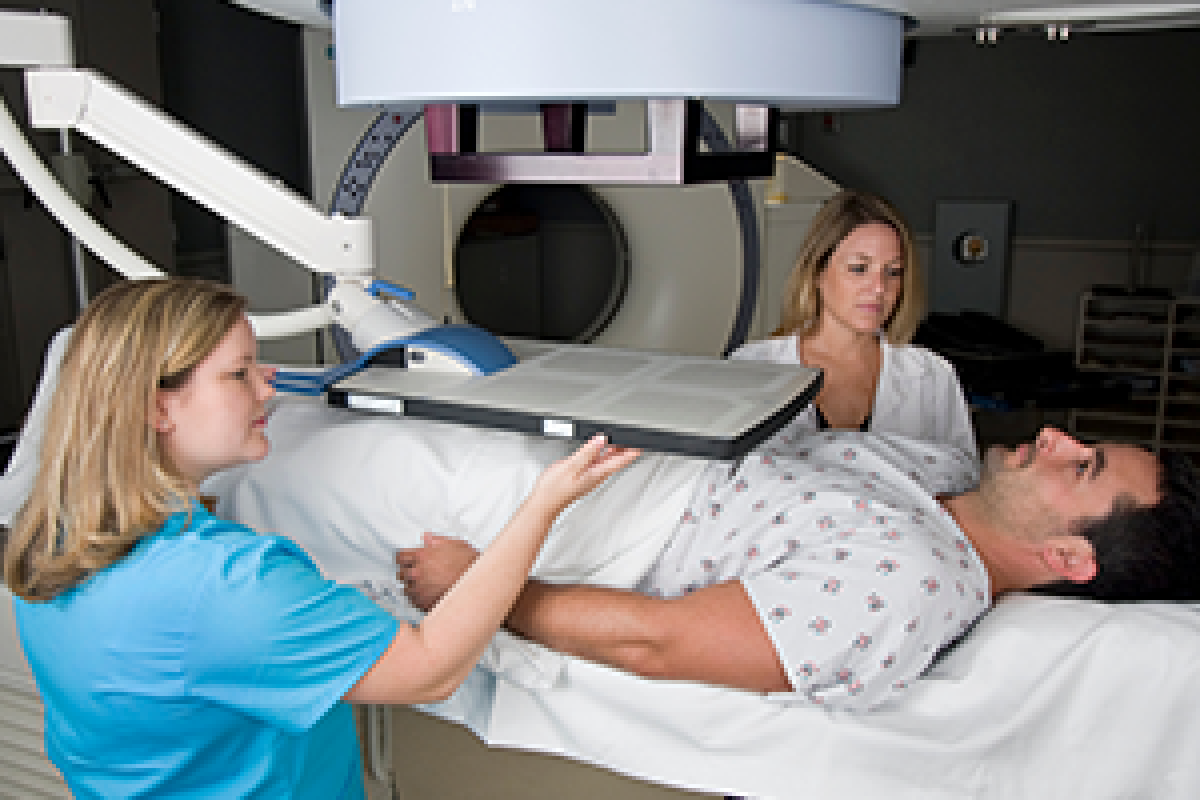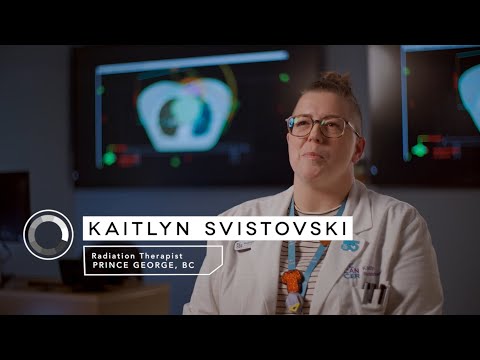Career Overview
This occupational group includes technologists who operate radiographic and radiation therapy equipment to give radiation treatment and produce images of body structures for the diagnosis and treatment of injury and disease.
Medical radiation technologists who are supervisors or instructors are included in this group.
People in this occupation:
- Work in hospitals, cancer treatment centres, clinics, radiological laboratories, research and education facilities, and in equipment sales and service and training
- Should have an interest in science and technology
- Need to be detail-oriented, patient and able to apply good problem-solving, critical-thinking and organizational skills
- Use computers for electronic imaging in most facilities
- Must be able to work well as part of a team and communicate effectively (to both co-workers and patients)
- Need to work compassionately with patients who have acute and chronic illnesses
Job Titles
Duties
Medical radiation technologists are divided into three groups: radiological technologists, nuclear medicine technologists and radiation therapists. All occupations in this group provide patient appropriate care throughout procedures and the treatment process. The specialized duties for these occupations are described below.
Special duties
Radiological technologists:
- Operate X-ray, radiographic and fluoroscopic equipment, computerized tomography (CT) scanners, mammography units or magnetic resonance imaging (MRI) scanners to produce radiographs or anatomic images of the human body for the diagnosis by radiologists of disease or injury
- Record and process patient data, do basic verification and quality control checks on radiographic and film processing equipment, provide appropriate care for patients during the radiographic examination and apply radiation protection measures
- Explain procedures, position patient and equipment and apply radiation protection measures
- May also train and supervise student radiographers or supervise other radiological technologists
- May specialize in areas such as computerized tomography, angiography, mammography, magnetic resonance imaging, interventional radiology, dosimetry, stereotaxy or brachytherapy
Nuclear medicine technologists:
- Prepare radiopharmaceuticals such as radionuclides and give them to patients or biological samples
- Operate radiation detection equipment, such as gamma cameras, scanners, scintillation counters, tomodensitometers and ionization chambers to acquire data for use by nuclear medicine physicians in the diagnosis of disease
- Do diagnostic procedures using radioactive materials on biological specimens, such as blood and urine
- Record and process the results of procedures, check equipment to make sure it operates properly, provide appropriate care for patients during examinations and apply radiation protection measures
- May also train and supervise student nuclear medicine technologists or supervise other nuclear medicine technologists
Radiation therapists:
- Operate linear accelerators, cobalt 60, X-ray and other radiation therapy equipment to give radiation treatment prescribed by radiation oncologists
- Check radiation therapy equipment to make sure it operates properly and help radiation oncologists and clinical physicists with preparation of radiation treatment plans
- Help prepare sealed radioactive materials such as cobalt, radium, cesium and isotopes
- Help build devices such as plaster casts and acrylic moulds to assist with radiation treatments
- Monitor patients' physical and psychological well-being during the entire course of treatment and advise patients regarding the side effects of radiation
- May also train and supervise student radiotherapy technologists or supervise other radiotherapy technologists
- May specialize in dosimetry, stereotaxy and brachytherapy
Earnings
Earnings is income that workers receive in exchange for their labour. Depending on the type of employment, earnings can be in the form of wages (hourly), salaries (fixed monthly or annual) or self-employed earnings.
Work Environment
# Workers Employed
2,585% Employed Full Time
61%Medical radiation technologists typically work 37–40 hours per week. Those working in hospitals often rotate shifts, may work on weekends and holidays and can often expect to be on call in case of an emergency. Part-time work is also available.
The work is generally highly technical and mentally demanding. Most medical radiation technologists are employed in clean, bright and well-ventilated settings. They work at diagnostic machines and electronic imaging/digital archive systems, but workers also spend about half of their time working with patients.
Physical stamina is important since these workers are on their feet for long periods and may have to lift or turn patients. Workers may also have to move overhead equipment.
Although radiation hazards exist, they are reduced by the use of lead aprons, gloves and other shielding devices, as well as by instruments monitoring radiation exposure. Medical radiation technologists wear badges that measure radiation levels and detailed records of their overall lifetime dose are kept. As a result, radiation exposure is extremely low. With the phasing out of film processors in favour of electronic imaging, most technologists are no longer exposed to chemicals and fumes.
Career Pathways
With sufficient work experience and training, medical radiation technologists can advance to supervisory positions in radiography, fluoroscopy, nuclear medicine, CT scan and MRI fields. Some may also pursue positions as clinical instructors or start their own businesses.
Occupational Interests
It’s important to understand what kinds of occupations align with your interests.
For more about occupational interests visit Skills for the Future Workforce > Characteristics.
Here are the top occupational interest(s) for this career profile:
Education, Training and Skills
Completion of a two- to three-year college, hospital or other approved program in diagnostic radiography (for radiological technologists), nuclear medicine technology (for nuclear medicine technologists) or radiation therapy (for radiation therapists) is required for certification. Some workers may have a bachelor of health sciences degree in radiography, nuclear medicine or radiation therapy.
In addition, a period of supervised practical training is usually necessary. Experience as a medical radiation technologist is required to become a supervisor or instructor.
Requirements for full-practice membership or registration in the profession include:
- Writing and passing the Canadian Association of Medical Radiation Technologists (CAMRT) certification exam
- Registration with the British Columbia Association of Medical Radiation Technologists (BCAMRT), which also allows them to be a member in the national CAMRT
Those enrolled in a recognized medical radiation technology program can become a student member of BCAMRT. For more information, visit the CAMRT website at www.camrt.ca and the BCAMRT website at www.camrt.ca/bc.
In B.C., certification is not needed to work as a medical radiation technologist. However, in practice, employers generally require certification and registration with CAMRT and/or BCAMRT. Industry sources report that employers will accept qualified technologists for new job openings if they are graduates of an accredited program and either certified with or are eligible for certification with CAMRT.
Education programs in B.C.

Top Skills
Every job calls for a certain set of skills. Knowing those skills is the first step in finding a good career fit.
Here, you will find the 10 most relevant workplace skills. Some are more important to achieving success in a certain career than others. These skills may come naturally to you or you may need to gain them through education, training and experience.
See the list of work-related skills below, ranked in order of importance for this career. Check out the list and see if this career matches your skills—take that first step!
Giving full attention to what other people are saying, taking time to understand the points being made, asking questions as appropriate, and not interrupting at inappropriate times.
Understanding written sentences and paragraphs in work-related documents.
Using logic and reasoning to identify the strengths and weaknesses of alternative solutions, conclusions or approaches to problems.
Talking to others to share information effectively.
Keeping track of and assessing your performance, other individuals, or organizations to make improvements or take corrective action.
Being aware of others’ reactions and understanding why they react as they do.
Communicating effectively in writing as appropriate for the needs of the audience.
Actively looking for ways to help people.
Watching gauges, dials or other indicators to make sure that a machine is working properly.
Considering the relative costs and benefits of potential actions to choose the most appropriate one.
Labour Market Statistics
Discover data, facts and information that have been gathered and analyzed. Learn about the characteristics of the economy and labour market in B.C.
Employment
Find out about employment types and trends by region and industry.
Employment
2,585Employment by Region







| Region | Employment | % Employment of this Occupation |
|---|---|---|
| Cariboo | 115 | 4.4% |
| Kootenay | 65 | 2.5% |
| Mainland/Southwest | 1,490 | 57.6% |
| North Coast and Nechako | 45 | 1.7% |
| Northeast | 40 | 1.5% |
| Thompson-Okanagan | 385 | 14.9% |
| Vancouver Island/Coast | 445 | 17.2% |
Labour Market Outlook
The B.C. Labour Market Outlook is a 10-year forecast of the expected supply and demand for labour in the province. It’s usually updated every year. The purpose is to provide British Columbians with the knowledge to make informed decisions on careers, skills training, education and hiring.
Forecasted Job Openings (2025-2035)
1,870Forecasted Job Openings
Forecasted Employment Growth Rate
Composition of Job Openings
Job Openings by Region (2025-2035)







| Region | Job Openings | Avg. Annual Employment Growth |
|---|---|---|
| Cariboo | 80 | 1.6% |
| Kootenay | 40 | 2.2% |
| Mainland/Southwest | 1,110 | 2.2% |
| North Coast and Nechako | 10 | 1.1% |
| Northeast | 20 | 1.1% |
| Thompson-Okanagan | 220 | 2.2% |
| Vancouver Island/Coast | 380 | 2.1% |
Industry Highlights
Learn about the opportunities in B.C.'s major industries, including employment trends, earning potential, locations of work and more.
Forecasted Job Openings by Industry
| Industry | Job Openings (2025-2035) |
|---|---|
| Health Care and Social Assistance | 1,850 |
| Wholesale Trade | 10 |
| Professional, Scientific and Technical Services | 10 |
Insights from Industry
While most new job openings will come from job creation, there will be also be a considerable number of jobs available due to the need to replace retiring workers.
The growing demand for health-care services will increase job opportunities for medical radiation technologists. Population growth, an aging population and technological advances in diagnosis and treatment are contributing to the demand for X-rays, CT, MRI, nuclear medicine tests and other diagnostic procedures. Advances in radiation-based diagnostics and treatments may also increase the need for these services.
Industry sources report current worker shortages throughout the Lower Mainland, along with a higher need for casual workers on Vancouver Island.
For those seeking work in hospital settings, full-time positions are difficult to find when starting a career. However, there will be plenty of on-call and part-time opportunities.
Resources
-
B.C. Ministry of Healthwww.gov.bc.ca/health/
-
Canadian Association of Medical Radiation Technologists - British Columbiawww.camrt.ca/bc/
-
Canadian Association of Medical Radiation Technologists (CAMRT)www.camrt.ca/
-
Health Match BCwww.healthmatchbc.org/
-
Provincial Health Services Authority (PHSA) – Jobsjobs.phsa.ca/








